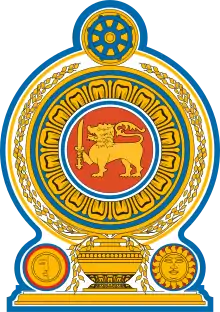Kachcheri
 |
|---|
| This article is part of a series on the politics and government of Sri Lanka |
|
|
A kachcheri or district secretariat is the principal government department that administrates a district in Sri Lanka. Each of the 25 districts has a kachcheri.
The main tasks of the District Secretariat involve coordinating communications and activities of the central government and Divisional Secretariats. The District Secretariat is also responsible for implementing and monitoring development projects at the district level and assisting lower-level subdivisions in their activities,[1] as well as revenue collection and coordination of elections in the district.[2] The head of a District Secretariat is the District Secretary also known as the Government Agent.
Kachcheri is a Hindustani word[3][4] initially used for the Revenue Collector's Office in the early years of the British Colonial Administration in Ceylon.[5] (Sri Lanka) Revenue collection was a main feature of the Dutch pattern of colonial administration. In the first half of the 19th century, the British colonial administrators were able to move towards a more organised form of government with civil and revenue administration. Thus, the collector's office, which continued to be locally known as the kachcheri was converted into the Government Agent’s Office.[5] Even after the independence, kachcheri was retained as the district administrative centre and focal point of the provincial administration and placed it under a government agent.[6] However, in 1987, the 13th Amendment to the Constitution of the Democratic Socialist Republic of Sri Lanka[7] made provisions for the establishment of Provincial Councils.[8] Thus, the Provincial Council Administration which came into effect in January 1990 changed kachcheri administration which had remained unaltered since the first half of the 19th century.
Notable Kachcheri buildings
- The old Kachcheri building in Old Park, Jaffna is a now a protected monument.[9]
- The old Kachcheri building in Anuradhapura now houses an archaeological museum (Anuradhapura Archaeological Museum).
References
- "District Secretariat—Vavuniya". District and Divisional Secretariats Portal—Ministry of Public Administration and Home Affairs. Archived from the original on 2010-11-12. Retrieved 2009-07-29.
- "Performs Report and Accounts—2008" (PDF). District and Divisional Secretariats Portal—Ministry of Public Administration and Home Affairs. Archived from the original (PDF) on 2011-10-03. Retrieved 2009-07-29.
- Senaveratna, John M.; Bell, Harry Charles Purvis; Lewis, John Penry (1916). The Ceylon Antiquary and Literary Register, Volume 1. The Times of Ceylon. p. 111.
- Garthwaite, L (1870). A Collection of Official Documents in the Canarese Language, consisting of Urzees and other Papers filed in Courts of Justice, for the Use of Candidates for the Indian Civil Service: Compiled by Order of the Secretary of State for India. Government of Madras Basel Mission Press. p. 65.
- Wickramanayake, S S, The Management of Official Records in Public Institutions in Sri Lanka: 1802–1990, p 28, Unpublished PhD Thesis, University of London, 1992
- Wijeweera, B S, Colonial Administration System in Transition, Dehiwala (Colombo), Tissara Prakasakayo, 1984, p7
- Parliament of Democratic Republic of Sri Lanka, Thirteenth Amendment to the Constitution, Certified on 14 November 1987, Published as a Supplement to Part II of the Gazette of the Democratic Socialist republic of Sri Lanka, 20 November 1981, Colombo, Govt. Print., 1987
- Provincial Councils Act No 42 of 1987, 20 November 1987, Colombo, Govt. Print., 1987
- "Government Notifications – THE ANTIQUITIES ORDINANCE (CHAPTER 188) Order under Section 19" (PDF). The Gazette of the Democratic Socialist Republic of Sri Lanka. 1722. 2 September 2011. Archived from the original (PDF) on 23 September 2015. Retrieved 7 July 2015.